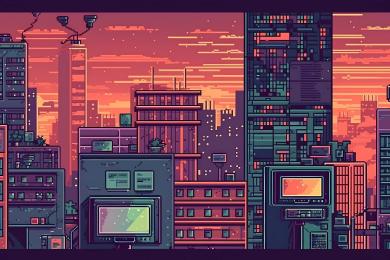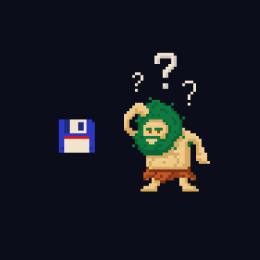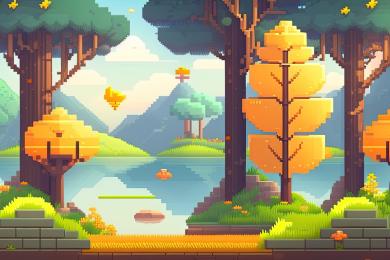Indie games have always had some fantastic, old-school graphics, and one particular style that has captivated players is pixel art games.
These visually stunning and nostalgic games have managed to carve a niche for themselves in the gaming industry, appealing to both young and old gamers alike.
In this article, we will explore the world of indie games with pixel art, their unique characteristics, and the reasons why they continue to captivate players.
What is Pixel Art?
Pixel art is a form of digital art that utilizes tiny, square-shaped pixels to create images. Each pixel serves as a building block, carefully placed to form intricate and detailed visuals.
This art style originated in the early days of video games when limited hardware capabilities required developers to use low-resolution graphics. However, over time, pixel art has evolved into a deliberate aesthetic choice, with indie game developers using it to create visually striking and nostalgic experiences.

Pixel art, with its low-resolution graphics and limited color palettes, has a unique appeal that sets it apart from other art styles. The deliberate use of blocky shapes and pixelated details creates a distinctive look that is instantly recognizable.
This visual style allows indie games to stand out in an oversaturated market, attracting players who are tired of the same realistic graphics seen in many AAA titles.
Additionally, the use of pixel art can evoke a sense of nostalgia in players, particularly those who grew up playing video games in the 80s and 90s. The pixelated visuals of their favorite childhood games can transport them back to a simpler time in gaming history, creating a deep connection and a sense of familiarity.
The Appeal of Indie Games with Pixel Art
Nostalgic Charm
One of the main reasons why indie games with pixel art have gained such a devoted following is their ability to invoke a sense of nostalgia. Many gamers who grew up playing video games in the 80s and 90s have a deep connection to the pixelated visuals of their favorite childhood games.
By using pixel art, indie game developers tap into this nostalgia, transporting players back to a simpler time in gaming history.

Pixel art games with their retro aesthetics and pixelated visuals can bring back fond memories of classic games like Super Mario Bros., The Legend of Zelda, or Pokémon.
The pixelated graphics, limited color palettes, and simple character designs evoke a sense of nostalgia that resonates with players who have fond memories of playing these games during their childhood.
The pixel art style serves as a visual time machine, allowing players to relive the magic and excitement of those early gaming experiences.
Unique Visual Style
Pixel art provides indie game developers with a unique visual style that sets their games apart from mainstream titles. The deliberate use of limited colors, blocky shapes, and pixelated details creates a distinctive look that is instantly recognizable. This visual style allows indie games to stand out in an oversaturated market, attracting players who are tired of the same realistic graphics seen in many AAA titles.

The pixel art style allows developers to create visually striking and memorable gaming experiences. The deliberate use of limited colors and pixelated details forces developers to focus on creating visually appealing designs using a minimalist approach.
This unique visual style not only sets indie games apart from mainstream titles but also allows developers to convey emotions and tell stories in a more abstract and imaginative way. The simplicity and charm of pixel art can evoke a sense of wonder and curiosity, drawing players into the game world and immersing them in its unique atmosphere.
Creativity and Limitations
Pixel art presents a unique challenge for game developers, as they must work within the limitations of the art style to create visually appealing and engaging experiences.
These limitations, such as limited color palettes and low resolution, force developers to think creatively and find innovative solutions to convey their visions. This creativity often shines through in indie games, resulting in unique and memorable gameplay experiences.
The constraints of pixel art push developers to think outside the box and find creative solutions to overcome the limitations of the art style. Limited color palettes require careful consideration of color choices to create depth and variety in the visuals.
Low-resolution forces developers to focus on using pixel placement strategically to create detailed and recognizable objects. These limitations not only foster creativity but also encourage developers to experiment with different techniques and styles, leading to the creation of visually stunning and innovative games.
Standout Indie Games with Pixel Art
Stardew Valley
Stardew Valley is a beloved indie game that combines pixel art with farming simulation gameplay. Developed by Eric Barone, this game offers players a chance to escape to a charming rural town, where they can grow crops, raise livestock, and build relationships with the town’s inhabitants.
The pixel art visuals perfectly capture the game’s cozy and nostalgic atmosphere, making it a delightful experience for players of all ages.
Stardew Valley showcases the versatility of pixel art in creating immersive and captivating game worlds. The pixelated visuals beautifully depict the idyllic countryside, with its lush fields, quaint buildings, and charming characters.
The attention to detail in the pixel art brings the game world to life, making every interaction and exploration feel meaningful and rewarding. The use of pixel art in Stardew Valley not only adds to the game’s nostalgic charm but also allows players to immerse themselves in a visually stunning and vibrant virtual world.
Celeste
Celeste, developed by Matt Makes Games, is a challenging platformer that tackles the sensitive subject of mental health. The game follows the journey of a young girl named Madeline as she climbs a treacherous mountain.
The pixel art visuals beautifully convey the game’s emotional depth, while the precise controls and level design provide a satisfying and exhilarating gameplay experience.
Pixel art in Celeste goes beyond its visual appeal and serves as a powerful storytelling tool. The pixelated graphics effectively convey the emotional struggles and triumphs of the main character, Madeline. The simplicity and abstraction of the pixel art style allow players to focus on the core mechanics of the game, creating a seamless integration between gameplay and narrative. The precise controls and level design, combined with the pixel art visuals, create a challenging and immersive experience that resonates with players on an emotional level.
Hyper Light Drifter
Hyper Light Drifter, developed by Heart Machine, is an action-adventure game set in a post-apocalyptic world. Players take on the role of the Drifter, an enigmatic character on a quest to uncover the secrets of a dying world. The game’s pixel art visuals create a hauntingly beautiful atmosphere, complemented by its challenging combat and exploration mechanics.
Hyper Light Drifter showcases how pixel art can be used to create immersive and atmospheric gaming experiences.
Pixel art in Hyper Light Drifter creates a unique and atmospheric game world that captivates players from the moment they start playing. The detailed pixel art environments and character designs evoke a sense of desolation and mystery, perfectly capturing the post-apocalyptic setting of the game.
The use of limited color palettes and pixelated details adds to the game’s enigmatic atmosphere, allowing players to immerse themselves in a visually stunning and atmospheric experience. The challenging combat and exploration mechanics, combined with the pixel art visuals, create a gameplay experience that is both engaging and memorable.
The Future of Indie Games with Pixel Art
As the indie game industry continues to thrive and evolve, it is clear that pixel art will remain a significant part of its identity. While advancements in technology have made realistic graphics more accessible, the charm and uniqueness of pixel art continue to captivate players.
Indie game developers will undoubtedly continue to push the boundaries of what can be achieved with this art style, creating memorable experiences for gamers worldwide.
Pixel art has proven its longevity and appeal in the indie game scene. It’s distinctive visual style and nostalgic charm resonate with players of all ages, creating a sense of connection and immersion. As technology continues to advance, pixel art will likely evolve as well, incorporating new techniques and styles while staying true to its roots.
The future of indie games with pixel art holds endless possibilities, with developers constantly pushing the boundaries of what can be achieved within the art style. Players can look forward to experiencing even more visually stunning and captivating games that pay homage to the nostalgia and creativity of pixel art.
Conclusion
In conclusion, indie games with pixel art have found a special place in the hearts of gamers. Their nostalgic charm, unique visual style, and creativity within limitations make them stand out in the gaming industry.
With standout titles like Stardew Valley, Celeste, and Hyper Light Drifter, it is clear that pixel art can create immersive and captivating gaming experiences. As the indie game scene evolves, we can expect pixel art to remain a beloved and integral part of the industry, delighting players with its timeless appeal.
What’s your favorite pixel art game? Let us know in Discord!
FAQ – Frequently Asked Questions
Q: What is pixel art?
A: Pixel art is a form of digital art that uses small, square-shaped pixels to create images. It originated in the early days of video games and has evolved into a deliberate aesthetic choice for indie game developers.
Q: What is the appeal of indie games with pixel art?
A: Indie games with pixel art have a nostalgic charm that resonates with players who grew up playing video games in the 80s and 90s. The unique visual style sets them apart from mainstream titles and allows for creativity within the limitations of the art style.
Q: Can you give examples of standout indie games with pixel art?
A: Some standout indie games with pixel art include Stardew Valley, Celeste, and Hyper Light Drifter. These games showcase the versatility of pixel art in creating immersive and captivating gaming experiences.
Q: What does the future hold for indie games with pixel art?
A: Pixel art will likely continue to be a significant part of the indie game industry. As technology advances, pixel art may incorporate new techniques and styles while staying true to its nostalgic roots, creating visually stunning and captivating games.